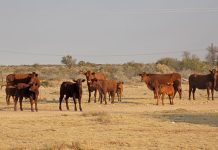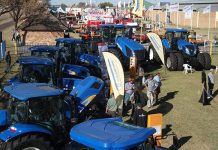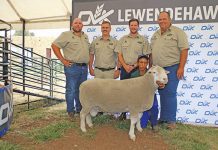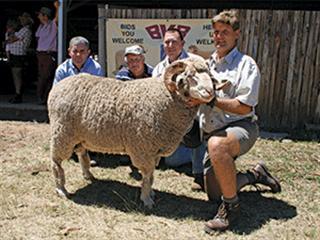A relative newcomer to stud breeding, Zelda Brits had to learn fast. Chris Nel visited her and her husband Attie on their Bronkhorstspruit smallholding to hear about the challenges facing a women breeder building a successful 210-ewe stud on 8,5ha.
Visit the 8,5ha Plot 64, on the farm Roodepoort in the Bronkhorstspruit district, and you’ll find two parallel, well-run intensive enterprises. About 2ha are used for Brits’s Sterkfontein Veevoere yard sheds and offices, and the goat pens and facilities of his wife Zelda’s Sterkfontein Kalahari Red Boer goat stud. The other 6,5ha is rainfed, planted pasture – of the Smuts finger grass (Digitaria eriantha) cultivar TipTop and the Rhodes grass (Chloris gayana) cultivar Katambora – with naturally occurring veld grasses as enthusiastic self-seeding volunteers. The pasture supports a flock of approximately 210 goats, including young rams, year-round. Goats are natural browsers, but are highly adaptable and do well on pasture. In addition, young ewes and rams get a daily supplement of pellets, which Attie produces himself, and chocolate maize.
The plot has a 100kVA Eskom line, used mainly to run equipment for feed processing and to generate security lights. Attie is considering installing a 100kVA generator to cope with power outages as the feed processing process is not designed to be interrupted. The plot has a strong borehole and future development on the farm will include putting the pasture under permanent, overhead sprinkler irrigation. E nvisaged is the use of a Floppy sprinkler system and a sustainable ultra high-density, short-rotation, long-rest grazing system to utilise the animal factor (trampling urine and dung) to rejuvenate the pasture and break parasite cycles. This would increase productivity and enable Zelda’s goal of 300 breeding ewes and the regular production of high-quality slaughter stock. She also wants a fully electrified boundary fence monitored by CCTV cameras.
Building the stud
“We started our flock of Kalahari Red goats in October 2003, after my husband saw an advertisement for an auction in Kuruman,” recalls Zelda. “We bought 10 ewes and a ram at that auction, and subsequently another 70 ewes from the same breeder. Initially we knew nothing about goat farming and since Bronkhorstspruit is not a traditional or natural goat-farming area, both us and the goats had some adaptation problems. We lost many ewes because we couldn’t diagnose disease quickly enough. But we learned fast and seldom lose animals now. Within a year, despite the losses, the flock doubled in size. We registered as a stud with the South African Boer goat Breeders’ Society and an inspector came out to approve our animals. We were in for a big surprise. After going through our flock, he explained that only 16 of our 136 goats could be classified as stud. This after the seller (no names – no packdrill) had certified in writing that around 80% of the animals we had originally bought from him were stud animals. We had learned another hard but valuable lesson.
Our current stud ewes are from Tollie Jordaan of Somerset East, Louis van Rensburg of Waterpan Genetics in Prieska and Jannie Esterhuizen from Namibia. We also bought Derrick, one of our stud rams and the Reserve Senior Champion at the Pretoria Show in 2007, from Jannie Esterhuizen. “It’s also from Jannie that we heard about Champion. He described Champion as an extraordinary ram. We waited for almost two years for him to come on auction and with the help of friends in Namibia, we managed to buy him. I have weaned his first kids and they are of a high quality.” Incidentally, Derrick and Champion were bred in Tsumeb, Namibia, and are half brothers from the same sire, but different dams.
Breeding for the best
The Kalahari Red Boer goat’s natural breeding cycle is late summer and autumn. Young ewes have a shorter season of receptivity than the older ewes. “For this reason we use two breeding seasons,” explains Zelda. “The season for mature ewes is from October to November when 100 ewes are run with a mature ram. The mating season for young ewes is between February and May at a ratio of one young ram to 10 young ewes. Young ewes selected for stud breeding are put with the rams when the ewes are at 40kg. “Most ewes lamb every eight to nine months. The lambing percentage in our flock is 191% and the weaning percentage 180%. The reproductive history of each ewe is recorded. Ewe-ram selection depends on the ewe’s history – how well she has bred with a specific ram and vice versa.” Zelda selects on a checklist of 32 characteristics. “A ewe should lamb every eight months, one that doesn’t will have to have outstanding characteristics – such as growth or maternal qualities – to save it from being culled.” I use my own flock book as well as the ARC’s Shepherd computer programme to record and monitor the breeding performance of the flock. I input birth and performance-related data on Shepherd. The programme can calculate provisional indices, but I would have been happier if it could also record veterinary and herd management data.”
Lambing time
Heavily pregnant ewes are removed from the flock and placed in individual maternity pens in the lambing enclosure. After lambing they’re kept in the pens for three days to bond with their lambs. The lambs are weighed and ear-tagged before being put on pasture with their dams. At 14 days the lambs are dosed with Vecoxan. At 30, 60 and 90 days they’re weighed and de-wormed. Lambs are usually weaned at 90 days or 20kg; those below 20kg at 90 days are weaned in groups at two-week intervals when they reach 20kg. Weaning weight and age are recorded. Weaned lambs are also inoculated against pasteurellosis and pulpy kidney, and injected with Multimin+SE. After this, all young animals are incorporated into the flock’s normal veterinary programme. Ewes are inoculated annually against enzootic abortion and the rams against brucellosis with Brucella Rev 1. Adult animals are inoculated twice yearly against pasteurellosis and pulpy kidney.
The value of shows
Zelda explains that many Kalahari Red buyers, buy on show results that confirm breed conformation and functionality. She has participated in only three shows so far and is pleased with the results. At the 2006 Springbokvlakte Show in Bela-Bela, she won the Junior and Reserve Grand Champion ewe, as well as the Reserve Senior Champion ram titles. At the Pretoria Show in 2007 the results were the same, the latter title taken by Derrick. “Entering my goats in shows has taught me a lot and helped improve my stud. I select young ewes for use in the stud strictly according to the breeding standards of the South African Boer goat Breeders’ Society, combined with the dam and sire’s performance records as guidelines.” Zelda has firm views on the value of shows. “It’s an excellent way to market and promote your stud and to compare your animals with those of other breeders, and get feedback from judges. However, there’s a lot of politics and pronouncements by judges don’t always make sense to me. There also seems to be some discrimination against women breeders, but this only inspires me to try harder. We all look forward to the World Show in Bloemfontein later this year.”
Hard-earned experience
“I would advise anyone thinking of starting to farm goats to first arm themselves with knowledge. This will save you agony and money. Get all the information you can on the common goat diseases in your area. A beginner without knowledge shouldn’t buy directly from a breeder, unless you feel you can completely trust him and he guarantees the animals he sells to you. Rather buy at auctions held under the auspices of the South African Boer goat Breeders’ Society. There, every goat has to be approved by two inspectors and classified fit for sale as either a commercial or a stud animal. The rules also state that a ewe four-tooth or older has to be certified pregnant or be suckling lambs. Prospective goat farmers can feel free to contact me at any time.” Contact Zelda Brits on 083 259 8178.
A fine sale coming up
Zelda will present her first production sale together with six other Kalahari Red goat breeders – (Willem Wagner of Tolwe, Kobus Reynders of Pyramid, Malan van Heerden of Pyramid, Walter Bredell from Pretoria, Callie Louw from Grootvlei and Johan de Beer of Makwassie) – at the Pretoria Show grounds on 19 April. On offer will be 130 ewes and 22 rams. Louis van Rensburg and Abrie Maritz will be the selectors. Pictures of the goats on auction will be available at www.sfv.co.za.
Mixing grass cultivars to optimise pasture
TipTop is a new Smuts finger grass (Digitaria eriantha) cultivar, available from the Van Rooyen brothers at Clocolan. It has narrower, softer leaves than the Irene cultivar. TipTop grows tall and upwards, while Rhodes grass spreads horizontally. The two complement one another, maximising production.
Ear tag identification system
All Zelda’s goats are fitted with numbered ear tags and the goat’s details input on the ARC’s Shepherd computer programme. Each year the ear tags are printed in a different colour. The numbers on the tags are also embossed. he ear tags are individually numbered identification tags, colour-coded per year, and fitted to the right ear of all three-day-old goats born into the stud. The year number (such as eight for 2008) is followed by a serial number. Ewes bought in from outside are fitted with yellow tags on the right ear. he registration number, obtained from the Registrar of Animal Improvement, is tattooed onto the left ear of one-month-old goats. Animals inspected by selectors from the Breeders’ Society are classified as either stud or flock, regardless of their pedigree. metal tag with the stud registration number is fitted to the left ear of stud animals. Flock animals don’t get metal tags. Animals with eliminating faults are culled and may not be offered at auctions or presented under the auspices of the society. An elite category may be introduced in future.









